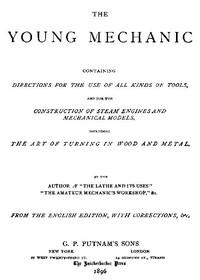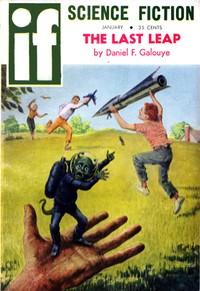Read this ebook for free! No credit card needed, absolutely nothing to pay.
Words: 82629 in 15 pages
This is an ebook sharing website. You can read the uploaded ebooks for free here. No credit cards needed, nothing to pay. If you want to own a digital copy of the ebook, or want to read offline with your favorite ebook-reader, then you can choose to buy and download the ebook.


: The Young Mechanic Containing directions for the use of all kinds of tools and for the construction of steam engines and mechanical models including the art of turning in wood and metal by Lukin James - Industrial arts; Handicraft
CHAP. PAGE
There never was a time when a taste for practical mechanics was so general among boys as it is now, in this year of grace 1870. There are comparatively few homes in which evidences of this hobby are not apparent in every odd nook and corner, in the shape of carpenter's tools, not always in first-rate condition, nor by any means generally in their proper places. A saw here, a hammer there, a gimlet, bradawl, or chisel elsewhere.
This probably results from the giant strides which have been made of late years in mechanical enterprise, and the introduction of machinery into every department, as a means of saving labour and facilitating the production of the various necessaries of life.
Man is an imitative animal, and in this as in other things "the child is father to the man;" and hence it comes to pass that the boy whose eyes are continually resting upon machinery of one sort or another sooner or later feels an innate desire to construct models of these gigantic mechanical labourers, by whose incessant but unfelt toil our several daily needs are so cheaply and plentifully supplied.
Even if the youthful mind does not always display highly-developed inventive faculties, there is very generally manifested a desire of personally constructing some one or more of those articles which conduce to the gratification of a particular hobby. If the boy has a taste for natural history, cases and cabinets will be made, for the reception of eggs, butterflies, and insects, or to contain stuffed specimens of animals and birds. If he has within him the elements of a sailor, his ingenuity will be exercised upon model boats and ships. If fond of dumb pets, rabbit hutches, dove-cots, or cages will afford him opportunities for the exercise of his constructive powers, and thus the young mechanic frequently lays the foundation of future eminence in that particular line of life to which his tastes naturally lead him.
There are few boyish hobbies in which assistance has not of late years been given by instruction books and guides of a high degree of excellence--natural history, botany, gardening, rearing and breeding all manner of pets--to each of these, well-written volumes have been devoted by able and experienced writers, but mechanical and constructive art has been somewhat neglected. Here and there, in periodical magazines, a few pages are dedicated to the subject, but no book about practical mechanics, written expressly for boys, has yet appeared.
But you must understand that when you cut with a saw you waste a little of the wood, which falls in the shape of sawdust, and so if you did not allow for this, your box would be too small. The waste depends on the thickness of the edge of the saw, where you will, if you examine it, see that the teeth spread out right and left to prevent it from sticking fast as it is used. Probably, you would waste three-eighths of an inch, which is nearly half an inch in cutting off the pieces, so that instead of a piece exactly 28 inches long, you must have it 28 1/2 inches, or even a little more.
I want you to understand all this before you set to work, even though at first you may get a carpenter to measure and cut it for you; because most small boys take no trouble of this kind, and consequently they are sure to make their boxes too large or too small, and they look very bad when done. However, as I said before, I expect my young readers to understand what they are about, and they must set out their work carefully, or they will never get on so as to be able to make good use of the later chapters of this book. A carpenter's rule is made like this .
Now, let us examine the tool called a square, without which the marks could not readily be drawn as a guide for the saw, where the strip of board is to be cut to make the sides and ends of the proposed box. Here is a drawing of one .
Hold it thus, and run the bradawl a little way into the lower piece, through the holes already made in the upper. Drive a brad through the middle hole first, which will hold it together, and then through the other two holes. If you have been careful, you will find this corner square and neat, and the wood not split in the least. Do the same with the other short piece, and then nail on the long side that is left. The frame of the box will now be complete.
No very special directions are needed about putting on the bottom. Leave all round an exactly even border of a quarter of an inch, and after it is nailed, you may neatly round off all its edges, to give it a finished appearance.
I shall now resume my directions in the first person, which I think is the more easy method both for master and pupil. The next specimen I propose, because it requires even more care than a box, but is at the same time perfectly within a boy's powers, is a birdcage. Of these there are such a number of varieties that it is difficult to settle upon the best kind to begin upon. I think, however, a wire cage will on the whole be the easiest to construct, only you must take great care in boring holes in the thin strips of wood, and, indeed, if you can get a birdcage-maker's awl besides the one you have, it will save both time and trouble. It is not made round with a flat end, but is three-cornered with a sharp point, so that it has three edges, and when it is carefully used and twirled round and round by the fingers in making holes, it will hardly ever split even very thin strips and pieces of wood. However, if you cannot get one never mind, you must use the common bradawl according to directions here given.
Free books android app tbrJar TBR JAR Read Free books online gutenberg
More posts by @FreeBooks


: The Divers by Stamers James Wood Wallace Illustrator - Science fiction; Parapsychology Fiction; Astral projection Fiction







